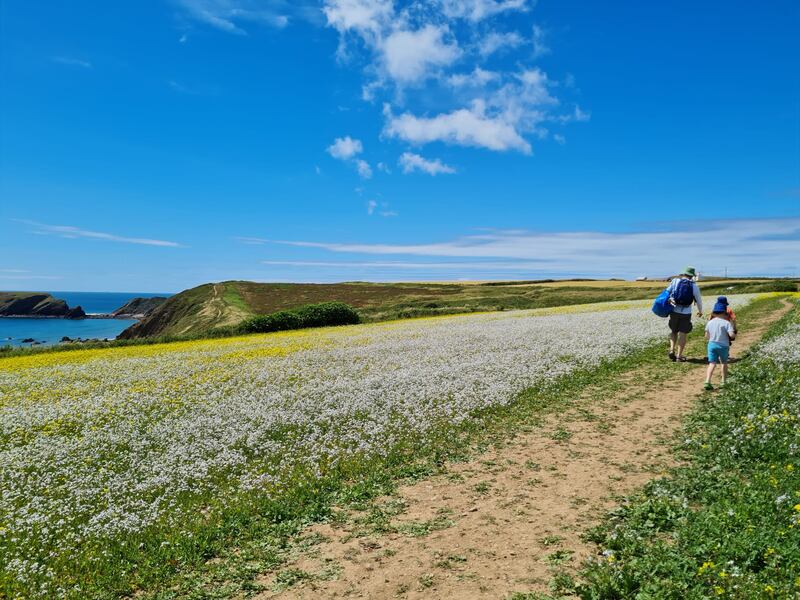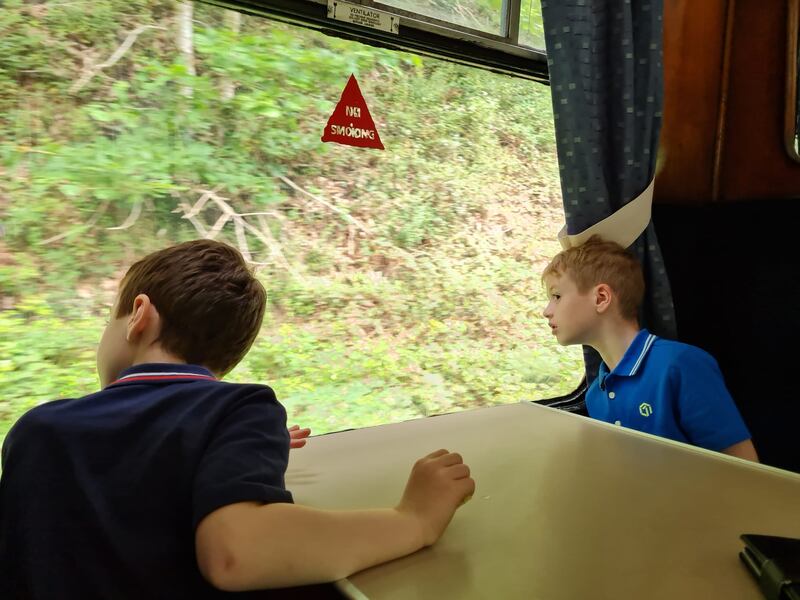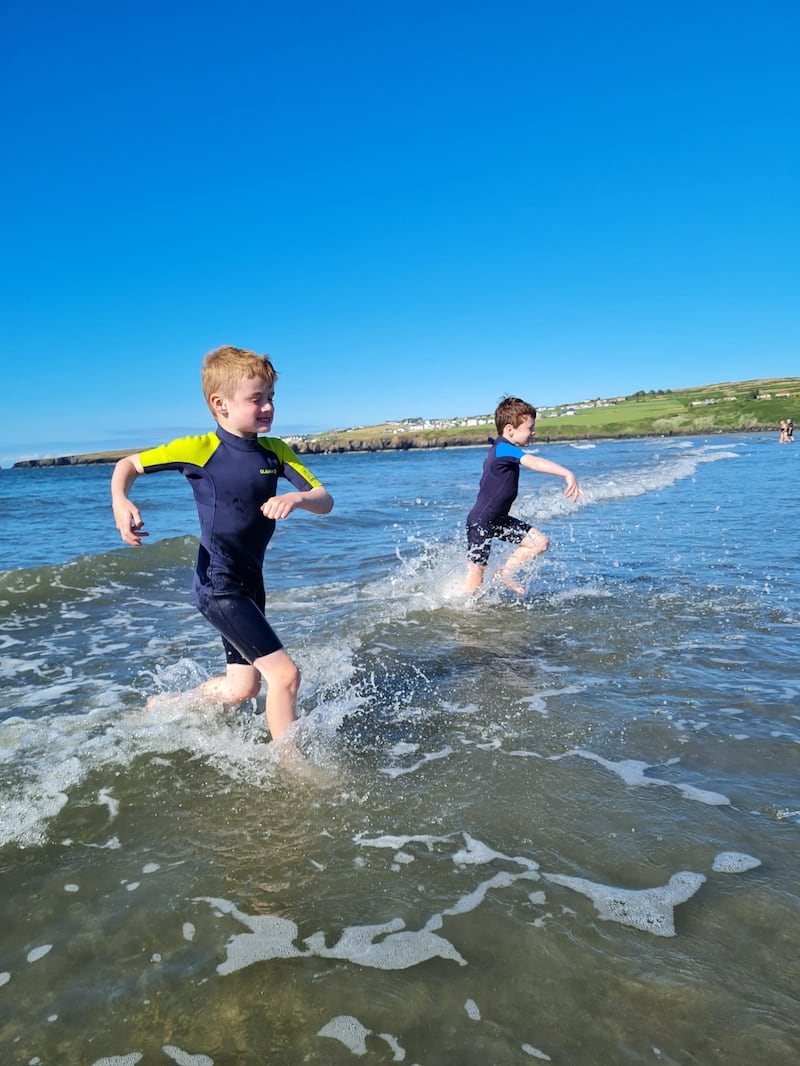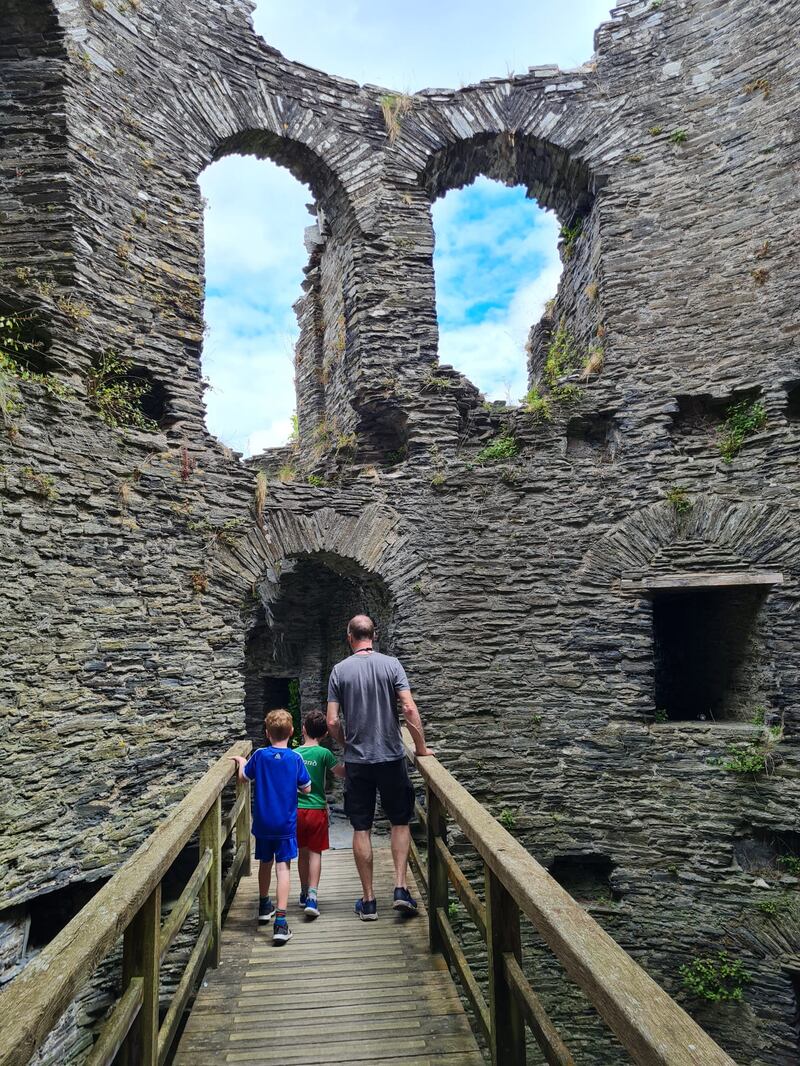Holidays with kids can be hard work. Airport chaos, baggage limits, heatstroke, mozzie bites, time difference — if it wasn’t called a holiday, you might call it torture. If you want an easy break, here’s a tip: west Wales is lovely.
On a clear day on the east coast of Ireland, you can see Wales, that’s how close it is. Some things so near can go overlooked, but for beaches, biking, hillwalking, culture, castles, dolphins, puffins, quaint pubs and picture-postcard villages, west Wales is the gem right under your nose.
“We’re driving into the ship?!” This trip starts on a high for our transport-nerd young boys. A straight spin down to Rosslare from north Wicklow, we were up on deck and waving goodbye to Ireland in under three hours. Ferry travel has its own pace. There isn’t the airport assault course of queues, checks and weigh-ins. There’s no wedging of wheelie cases into tiny overhead bins either. On the ferry, your car becomes one giant wheelie case. The bikes, the boogie boards, the boardgames, even the entire train set — you can bring the lot.
Travelling before UK school holidays, the boat wasn’t busy. With room to roam on-board, the three-and-a-half hour crossing to Fishguard passed easily. The play area is pretty minimalist but it’s a handy junction where kids can meet other kids and then talk at each other, sparing parents, for the journey. Indeed, an adult member of our party was left uninterrupted enough by children to watch the Ireland All Blacks test.
Maureen Dowd: Trump, America’s Emperor of Chaos, is far more dangerous this time
‘I was a Billie Barry kid. I’d like to be able to do the splits again’
I’m in my first serious relationship but too anxious to enjoy it. How do I relax?
Breda O’Brien: A lot is written about great leaders, but what the world needs now is great followers
Irish migrants who settled in Wales in the 5th century left their mark through the Ogham stones that still line the Welsh coastline
Docking at Fishguard, it was just a 25-minute drive to our bijou rented Golchdy cottage in Blaenffos, North Pembrokeshire. “Set on a working farm” doesn’t quite cover it — the house is bang in the middle of the farmyard and is all the lovelier for it. Paces from our front door, horses Quinn, Pili Pala (Welsh for “butterfly”) and Kit peered from the stable yard, cats lazed in the sun and hens wandered in our door with little bidding.
We were met warmly by Glenda who with her husband Wyn owns the 1,000 acre sheep, beef and arable holding. It turns out they can see Ireland from Wales too. The main farmhouse, which sleeps six, dates back to the 1800s. The farm buildings are likely much older, Glenda explained, pausing to persuade Button the cat from our feet. No, Glenda wasn’t “speaking cat”, we explained to the five year old. She was speaking Welsh, as she does every day. It was a lovely surprise to hear Welsh spoken on the streets, in shops and at the beach. Welsh Farmers Union meetings can be quite the racket, says Wyn.

Our lodgings gave us a ring side seat on life at Trefach farm. There’s Plas Pantyderi nearby too, a seven-century old manor run by Glenda and Wyn’s three daughters, which sleeps 21. Tired from an early start, we took Glenda’s suggestion of a leisurely bike ride on the quiet farm road from outside our door. The pleasantly bumpy track tunnelled us through brimming hedgerows and towering foxgloves, as sheep and cattle grazed in the fields either side.
Exploring Carmarthenshire, Ceredigion and Pembrokeshire was our plan. These three counties have cleverly teamed up with Wicklow, Wexford and Waterford in a tourism partnership called Celtic Routes. It’s all about encouraging visitors to Ireland and Wales to explore their shared Celtic heritage. It’s not something I knew much about. Long before the ferry, there was loads of too-ing and fro-ing between the two countries.
Irish migrants who settled in Wales in the 5th century left their mark through the Ogham stones that still line the Welsh coastline. And in return, Wales gave St Patrick to Ireland — or so they say. Before that, there were the Celts and both countries share their imprint in culture and language. So you’ll find Wales is a bit familiar but different enough to make things interesting.

On Sunday morning, we were back on the road. The steam train from Bronwydd Arms railway station wasn’t going to wait. If your children talk about sidings, gauges and the interoperability of Dart, Luas and diesel train tracks, you’ll know why this excursion was a draw.
The Gwili Railway is a standard gauge (the same as the Luas but different from the Dart) steam railway, three miles north of Carmarthen. Named after the river Gwili, alongside which it runs, it passes through picturesque farmland and steeply wooded hillsides. It’s staffed by a mostly volunteer group of older gentlemen railway enthusiasts, whose knowledge of and affection for trains our smallies are close to matching.
Trains have been a lifelong love for volunteer Tony. “In the 50s, we used to go into the station and buy a penny platform ticket — you used to buy a ticket to get on the platform to wave someone goodbye. They were expecting you to come off again, but you didn’t. You got on the train and you went around trainspotting all day.” At 80, he is still captivated.
A sharp toot and our 1930s-built steamer, No 1369, was off. The chuffing engine, puffs of steam billowing past our window and the smartly uniformed conductor who punched our tickets brought the golden age of rail vividly to life.
Another thing top of our holiday wishlist was to swim this side of the Irish Sea, so off we popped to Poppit Sands just 20 minutes from home for a dip. The beach is lifeguarded and has paid parking and toilets. “Saltier” was the verdict of our learner swimmers, who enjoyed boogie boarding in the small waves.

It was to sea again on Monday, this time on a puffin-spotting cruise from Martins Haven with Pembrokeshire Islands Boat trips. If the islands Skomar, Grasholm and Skokholm sound a bit Scandi, it’s because they are, skipper “Young Jim” James Hedley Philips, tells us. The Vikings hung around Wales for about 400 years in fact, renaming things. The names Swansea, Anglesey and Fishguard are their doing too.
The Vikings weren’t the first here though. There are signs of round houses on Skomar dating back 5,000 years, says Jim. With black bears, brown bears, wolves and adders on the mainland, the island was a predator-free refuge. These days, it’s all about the puffins and there are 58,000 of them on Skomar. We’re told puffins pair up aged five, raise a single chick called a puffling over a summer, and then return every year to the same burrow with the same mate. They can live to age 36 and eat about 40 fish a day. All around us, these cute stocky seabirds with parrot-like bills splay oversized orange feet to land on the water and fish.
Seafaring is hungry work so we headed for Runwayskiln, a cliff top cafe a short walk from the National Trust car park at Marloes Sands. For walkers on the Pembrokeshire Coast path nearby, it’s a must. We ordered some tasty rolls from its kiosk with puddings of butterscotch brownie, vegan love cake and Welsh ice cream. Runwayskiln Coastal Kitchen serves fish tacos, welsh beef and skin-on chips. Satiated, we hiked the 15-minute path down to Marloes Sands, a spectacular cove littered with giant, jagged boulders. The receding tide had left acres of rock pools, some several feet deep, and the boys ranged happily.
We didn’t know it was pub quiz night at the Ffynnone Arms in Newchapel when we stopped there on the way home. Or that buying a drink meant automatic quiz entry. The “name the famous doctor” picture round wasn’t Ireland’s finest hour against the Welsh, let’s just say.
It was a short drive next morning to the Welsh Wildlife Centre to cycle the Cardi Bach. This disused railway line runs from the car park through the Teifi Marshes Nature Reserve to Cardigan. Kingfisher, otter and wading birds can be spotted from hides along the way. You can visit Cardigan Castle across the river, or double back and cycle or drive a stretch of road to the 13th century Cilgerran Castle as we did. Perched on a craggy promontory, the views are dizzying.

In the afternoon, we headed north to the picturesque seaside town of New Quay on the Cardigan Bay coast. Its sheltered, golden beaches make it ideal for kids. The bay is famous for bottlenose dolphins and New Quay is pretty much dolphin central. After an evening swim, we got posh fish and chips from The Lime Crab, just up from the beach, and ate them watching dolphins from the harbour wall.
Wednesday, our last full day, we were off to Dolaucothi, the UK’s only Roman gold mine. Fitted with their own small yellow hard hats and brought underground, the kids were enthralled. The Romans mined for gold here 2,000 years ago, carving out hillsides and diverting rivers to find it. Our excellent tour guide Clive brought to life the hellish conditions endured by slaves. Some of their original pick-marks are still visible. Clive pointed to walled-up sections where having exhausted the mine, the Romans may have blocked in their spent workforce before moving on. Today, sheep graze in fields still marked by ravines and heaps made two thousand years ago.
Our last supper the night before departure was at the Nags Head Inn in Abercych. A family owned, riverside gastropub with rooms, it’s steeped in history. We dined outside in the gorgeous riverside beer garden, but with oak beams, original flagstone floors and log fires inside, this place would be heaven in winter too. The farm to fork menu had plenty of choice but the Welsh lamb shank with a local microbrewery ale was hard to resist.
There was time for one last swim at Newport Beach en route to the ferry the next day. We picked up some takeaway pasties from the Popty Cafe in pretty Fishguard and boarded the ferry with sandy feet. Glenda and Wyn promised to wave from Wales, but we’ll be back.
Joanne Hunt was a guest of Celtic Routes, a tourism partnership between west Wales and east Ireland celticroutes.info














